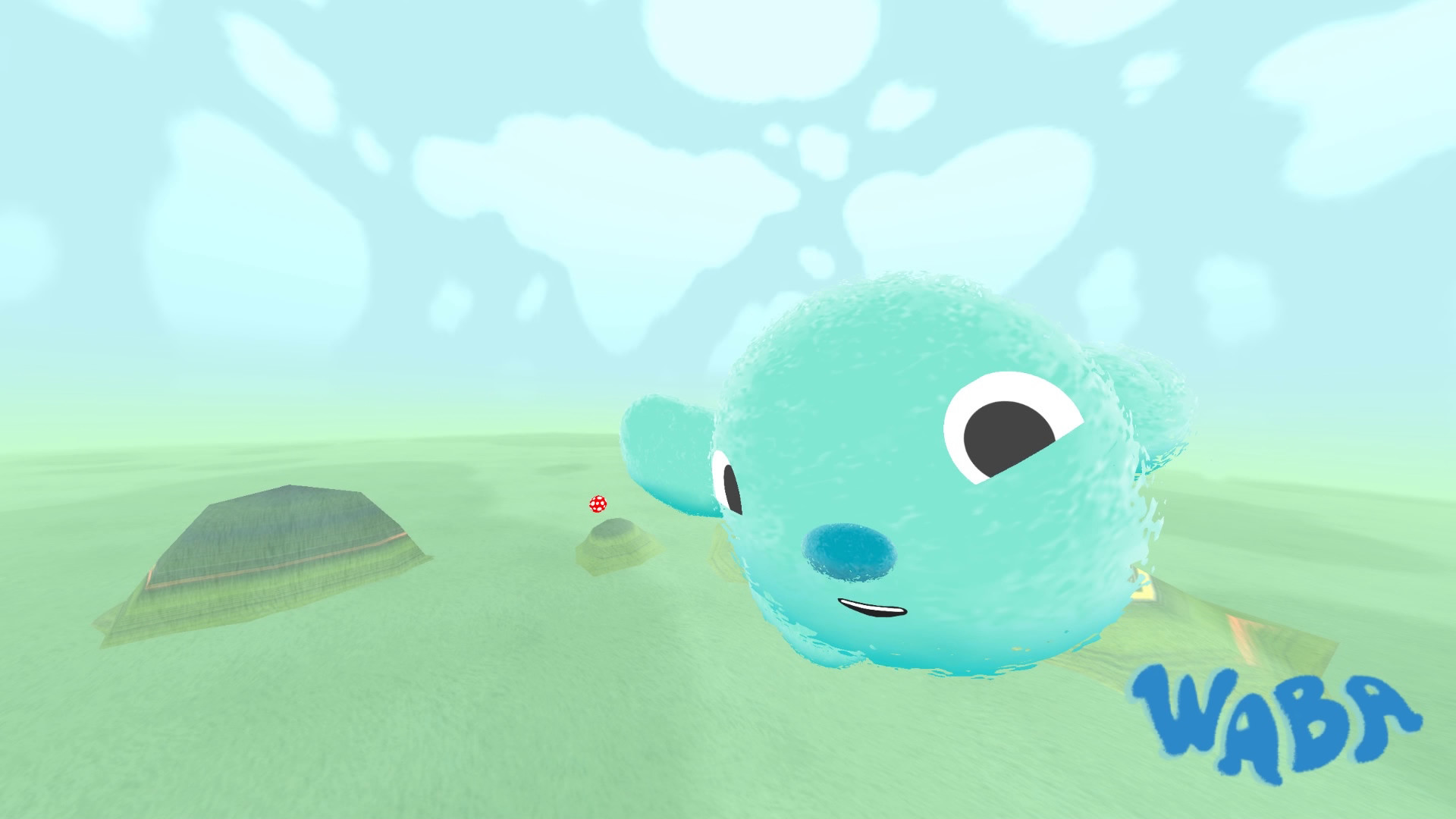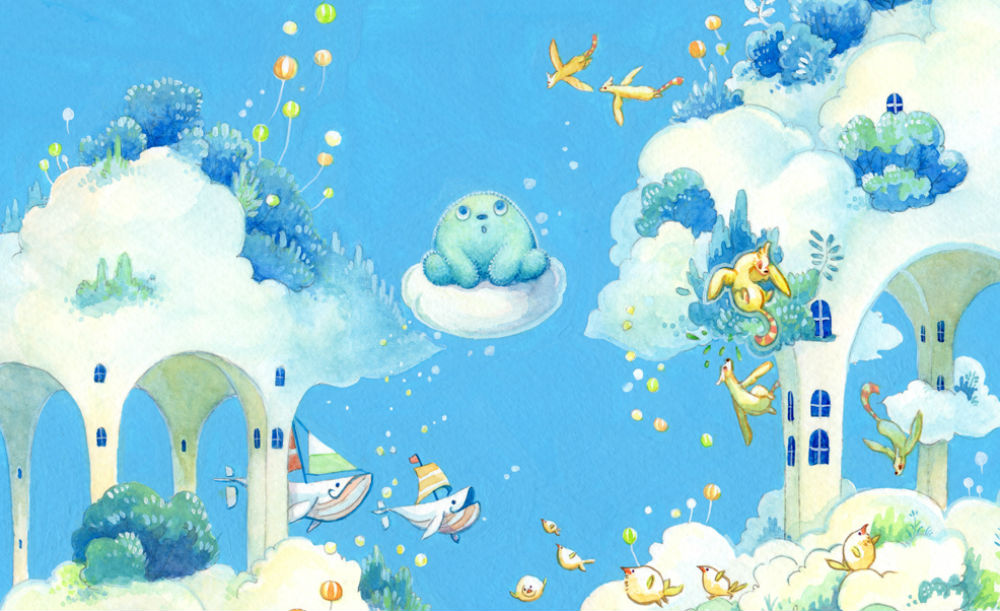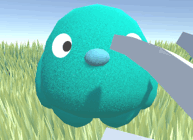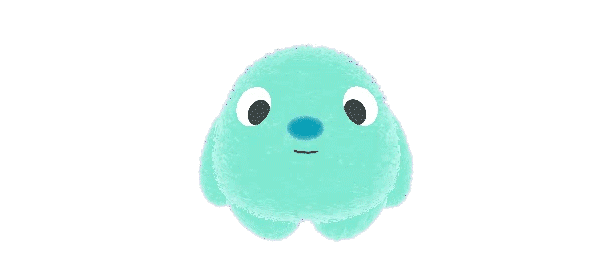Waba starts its journey when you place an egg in a hole. When it is born, Waba emerges from the hole as a squishy floating blob looking out into the world with big endearing eyes.
With my wobbly Mickey Mouse-like hands, I couldn’t help myself from poking, pushing and grabbing Waba. I threw a ball for Waba. I tucked Waba into bed and rocked Waba to sleep. And when Waba was hungry, I fed Waba carrots and rice balls.
Developer Edwon is offering little Waba eggs to the world now and asking if anyone wants to meet these innocent creatures. He’s also looking for suggestions about what people want to do next with them.
“I realized that I had been very foolish not to be more public with my development. I still had the attitude from my film days where it’s like you make this perfect jewel and then drop it on the world,” Edwon wrote in an email. “But software doesn’t work that way. So early access is my way of working with the community, adjusting to constant player feedback, and marketing the game all at the same time. Early access is also a great way to test demand and see what players actually want.”
Waba is $5 as of this writing, but that price is planned to increase as more features are added. You could play with Waba endlessly, of course, but at launch the software only includes three activities. Each new activity, or playset, is kind of like a “dollhouse for Waba. Each one has it’s own little way to interact with and maybe even change Waba.” Each can be accessed by pulling a cord hanging from the player’s wiggly wrist. Pull the cord with the other hand to reveal a bubble containing three small balls.
I grabbed a ball that looked like it had an even smaller red ball inside. I released the red ball, which burst, and with it the landscape quickly transformed into an open plain with a few hills popping up in the distance. Nearby, within arm’s reach, the serene little Waba waited for me holding the red ball.

“One trick I found to overcome a lot of the A.I. programming challenges was to constrain the scope of the AI. So in Waba, the player can only drop one playset at a time. So for example if the player drops the Bedroom down, Waba switches into ‘Bedroom AI mode,’ and then I only have to program Waba’s AI to be smart enough to handle all the possibilites that exist in that space,” Edwon wrote, also crediting producer/designer friend Tom Hart for the idea. “The user may not even notice this constraint, and it allows me to develop way more fun stuff, and have Waba react to every single thing that can possibly happen in that playset.”
Edwon is hoping to follow a model set out by other VR software creators like Anton Hand. Hand’s constant communication with buyers, and regular updates over the course of two years, helped build a passionate fan base on the path to selling more than 100,000 copies of his game.
“The long term plan is to try to bring deeper, subtler, emotions into the game,” Edwon wrote. “The goal is to make players really care about Waba in a deeper way beyond just the ‘it’s cuuuute’ reaction.”

He’s hoping to build a community of Waba fans over the next year using early access on Steam and Oculus, and that means he’s looking to see what people want. I would think most players would only get a few minutes of entertainment from the activities for Waba at launch, but I found those moments to be relaxing, happy and joyful. The theme song is playing in my head even as I write this. Prospective buyers should be considering whether they want to invest in what Edwon could do with this creature in the future as more playsets and game mechanics are added.
“Waba was designed to help people feel less lonely, and to give them that warm wholesome fuzzy feeling that I think is all too rare in the virtual world (and maybe the real one?),” Edwon wrote.
Meet Edwon

I met Edwon at a VRLA conference where he was showing a super early version of Waba. Previously, I also wrote about a project he worked on with Tyler Hutchison called Infinite Gesture. Edwon declined to provide his full name for both this and that earlier article.
Edwon said he put together the first prototype for what would become Waba in March of 2015. The character got its start as a Totoro-inspired “Sweat Pet” game he was prototyping for the Apple Watch, “where you sweat to feed the pet.”

It was called “Puni” then, meaning “squishy” in Japanese, and used a DK2 with the Leap Motion sensor to let you “touch” the creature with your fingers. According to Edwon, the Sweat Pet was never finished because someone else made something similar and “the VR version of the character was so much more fun.”

Though he said he received some funding from both Oculus and Leap Motion, he also spent portions of the last three years with no income while living on couches or floors. A network of friends and fellow developers have helped in various ways, from finding him a job, to ideas for Waba to offering a place to stay.

“I was very depressed for several months. It was hard, sad, and lonely,” Edwon wrote. “Needless to say I almost gave up, but for some reason, I didn’t. I had given up on so many half-finished prototypes before, and I was determined to finish this one.”
Edwon is a creative person that always “wants to try new things constantly,” and with Waba he sees a blank canvas that could be a lot of different things. This has also meant going down a lot of paths that turned into dead ends. After working on Waba for three years, with no feedback from a wider audience, he’s started “to think nobody was going to want it or buy it.

“I think an issue with the game is actually that it could be almost anything. It could be a virtual pet, it could be more like an interactive story, and it could be more like a sandbox. Every user wants something different out of it. I have my own sense of what I want out of it, and it’s actually a very simple thing. I just want to touch the creature, and feel like I have an emotional connection with it,” Edwon wrote. “Many users, however, want goals, they want Tamagotchi mechanics. For all these reasons, chasing these ideas has cost a lot of time, and at the same time I’ve been learning how to code a game, because there was no real programmer on the project throughout it’s entire development, so I had to just figure it out myself in the in between times.”
Though he was starting to believe no one would want Waba, Edwon is encouraged by the early reaction to the trailer.
You can meet Waba now on Steam or Oculus for $5 — compatibility is listed for Vive, Rift and Windows Mixed Reality with tracked motion controllers.

























